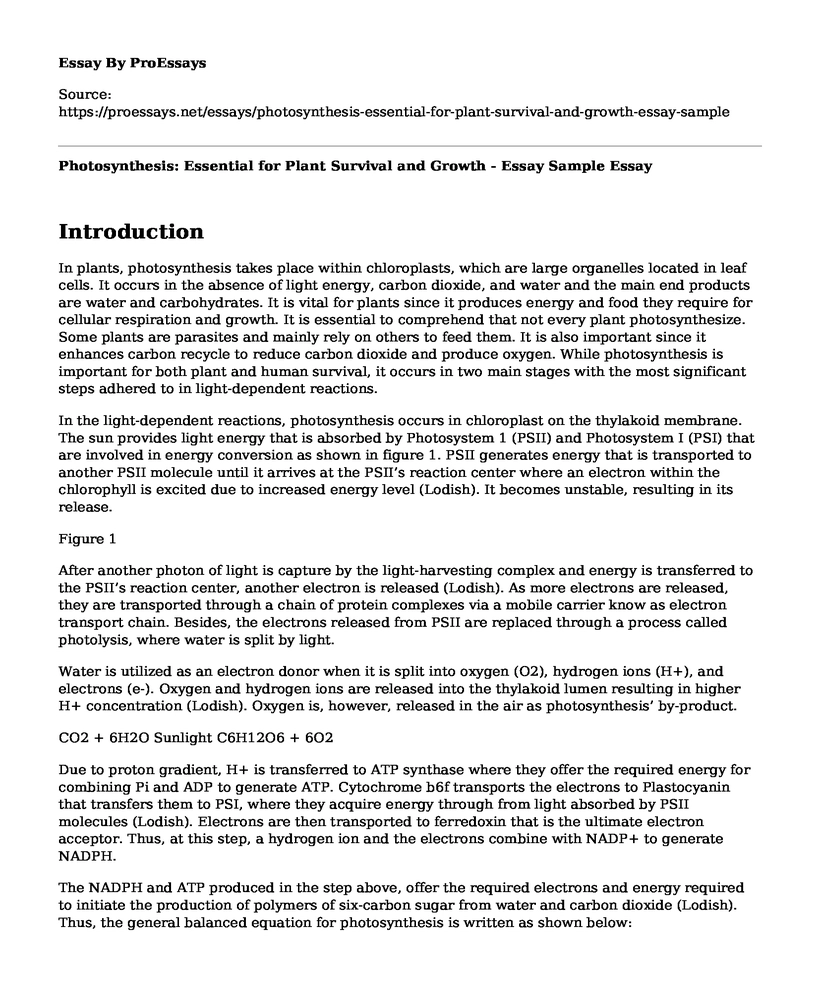Introduction
In plants, photosynthesis takes place within chloroplasts, which are large organelles located in leaf cells. It occurs in the absence of light energy, carbon dioxide, and water and the main end products are water and carbohydrates. It is vital for plants since it produces energy and food they require for cellular respiration and growth. It is essential to comprehend that not every plant photosynthesize. Some plants are parasites and mainly rely on others to feed them. It is also important since it enhances carbon recycle to reduce carbon dioxide and produce oxygen. While photosynthesis is important for both plant and human survival, it occurs in two main stages with the most significant steps adhered to in light-dependent reactions.
In the light-dependent reactions, photosynthesis occurs in chloroplast on the thylakoid membrane. The sun provides light energy that is absorbed by Photosystem 1 (PSII) and Photosystem I (PSI) that are involved in energy conversion as shown in figure 1. PSII generates energy that is transported to another PSII molecule until it arrives at the PSII’s reaction center where an electron within the chlorophyll is excited due to increased energy level (Lodish). It becomes unstable, resulting in its release.
Figure 1
After another photon of light is capture by the light-harvesting complex and energy is transferred to the PSII’s reaction center, another electron is released (Lodish). As more electrons are released, they are transported through a chain of protein complexes via a mobile carrier know as electron transport chain. Besides, the electrons released from PSII are replaced through a process called photolysis, where water is split by light.
Water is utilized as an electron donor when it is split into oxygen (O2), hydrogen ions (H+), and electrons (e-). Oxygen and hydrogen ions are released into the thylakoid lumen resulting in higher H+ concentration (Lodish). Oxygen is, however, released in the air as photosynthesis’ by-product.
CO2 + 6H2O Sunlight C6H12O6 + 6O2
Due to proton gradient, H+ is transferred to ATP synthase where they offer the required energy for combining Pi and ADP to generate ATP. Cytochrome b6f transports the electrons to Plastocyanin that transfers them to PSI, where they acquire energy through from light absorbed by PSII molecules (Lodish). Electrons are then transported to ferredoxin that is the ultimate electron acceptor. Thus, at this step, a hydrogen ion and the electrons combine with NADP+ to generate NADPH.
The NADPH and ATP produced in the step above, offer the required electrons and energy required to initiate the production of polymers of six-carbon sugar from water and carbon dioxide (Lodish). Thus, the general balanced equation for photosynthesis is written as shown below:
According to Priestly, during photosynthesis, carbon dioxide and oxygen are exchanged between animals and plants. A piece of evidence that supports this claim is when he put a plant and a burning candle in a sealed container that went off after a while. This is because the candle used all the available oxygen for combustion. However, he was able to light the candle again after two hours because oxygen, which allows combustion was produced. Therefore, this was an indication the gas generated during photosynthesis was oxygen.
Photosynthesis can be described in two major stages, but this paper focused on the light-dependent reactions phase. It occurs in the chlorophyll in the presence of light energy. The end products are ADP and NADPH. Oxygen is released as a by-product, which is supported by an experiment conducted by Priestly. Therefore, photosynthesis is essential as it absorbs carbon dioxide from the environment and releases oxygen that is useful to living organisms and other activities such as survival.
Works Cited
Lodish, Harvey, et al. "Photosynthetic stages and light-absorbing pigments." Molecular Cell Biology. 4th edition. WH Freeman, 2000.
Priestly, J. "Experiments and observations on different kinds of air, vol. 2." London: St. Paul’s Church-Yard (1775).
Cite this page
Photosynthesis: Essential for Plant Survival and Growth - Essay Sample. (2023, Aug 26). Retrieved from https://proessays.net/essays/photosynthesis-essential-for-plant-survival-and-growth-essay-sample
If you are the original author of this essay and no longer wish to have it published on the ProEssays website, please click below to request its removal:
- Anatomy Paper Sample: Muscle Lab Work Sheet
- Animal Bushmeat and Ethics Essay
- Impacts of Genetic Engineering on Agricultural Production Essay
- Sight Sense - Essay Sample
- Nature vs. Nurture: Unveiling the Impact of Genes on Intelligence - Annotated Bibliography
- Essay Example on Winter Survival: Nature's Mysteries, Animal Adaptations
- Digestive System: Maintaining Homeostasis - Essay Sample







